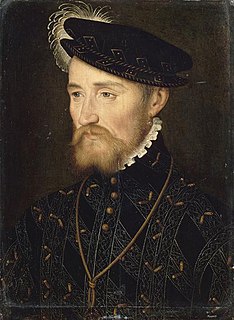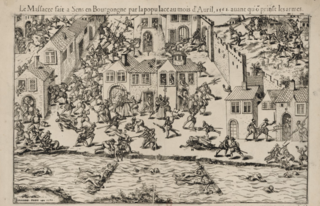
Catherine de' Medici, was an Italian noblewoman who was queen consort of France from 1547 until 1559, by marriage to King Henry II, and Queen mother of kings Francis II, Charles IX and Henry III from 1559 to 1589. The years during which her sons reigned have been called "the age of Catherine de' Medici" as she had extensive, if at times varying, influence in the political life of France.

Charles IX was King of France from 1560 until his death in 1574 from tuberculosis. He ascended the throne of France upon the death of his brother Francis II in 1560.

The French Wars of Religion were a prolonged period of war and popular unrest between Catholics and Huguenots in the Kingdom of France between 1562 and 1598. It is estimated that three million people perished in this period from violence, famine, or disease in what is considered the second deadliest religious war in European history.

The House of Guise was a French noble family, partly responsible for the French Wars of Religion.

The St. Bartholomew's Day massacre in 1572 was a targeted group of assassinations and a wave of Catholic mob violence, directed against the Huguenots during the French Wars of Religion. Traditionally believed to have been instigated by Queen Catherine de' Medici, the mother of King Charles IX, the massacre took place a few days after the wedding day of the king's sister Margaret to the Protestant Henry III of Navarre. Many of the most wealthy and prominent Huguenots had gathered in largely Catholic Paris to attend the wedding.

Michel de l'Hôpital was a French statesman.

Louis de Bourbon, Prince of Condé was a prominent Huguenot leader and general, the founder of the Condé branch of the House of Bourbon.

Francis de Lorraine II, Prince of Joinville, Duke of Guise, Duke of Aumale, was a French general and politician. A prominent leader during the Italian War of 1551–1559 and French Wars of Religion, he was assassinated during the siege of Orleans in 1563.

The Amboise conspiracy, also called Tumult of Amboise, was a failed attempt by Huguenots in 1560 to gain power over France by abducting the young king Francis II and arresting Francis, Duke of Guise and his brother, the Cardinal of Lorraine. It was one of the events directly leading up to the Wars of Religion that divided France from 1562 to 1598.
The Edict of Saint-Germain, also known as the Edict of January, was a decree of tolerance promulgated by the regent of France, Catherine de' Medici, in January 1562. It provided limited tolerance to the Protestant Huguenots in the Roman Catholic realm.

Wassy, formerly known as Wassy-sur-Blaise, is a commune in the Haute-Marne department in north-eastern France. Its population, as of 1999, is 3,294. Wassy has been twinned with the German town of Eppingen in north-west Baden-Württemberg since 1981.

The Battle of Coutras, fought on 20 October 1587, was a major engagement in the French Religious Wars between a Huguenot (Protestant) army under Henry of Navarre and a royalist army led by Anne, Duke of Joyeuse. Henry of Navarre was victorious, Joyeuse was killed while attempting to surrender.

The Edict of Amboise also known as the Edict of Pacification, was signed at the Château of Amboise on 19 March 1563 by Catherine de' Medici, acting as regent for her son Charles IX of France. The treaty officially ended the first phase of the French Wars of Religion. Moreover, the treaty restored peace to France by guaranteeing the Huguenots religious privileges and freedoms.
The Treaty of Hampton Court was signed on 22 September 1562 between Queen Elizabeth and Huguenot leader Louis I de Bourbon, prince de Condé. The treaty was concluded by François de Beauvais, Seigneur de Briquemault. Based on the terms of the accord, 3000 English troops were summoned to occupy Le Havre and Dieppe. Moreover, Queen Elizabeth promised to provide economic aid to the Huguenots. Once peace was restored in France, Elizabeth refused to withdraw her troops, stating that she had taken Le Havre not for religious reasons but to indemnify her for the loss of Calais, which was rightfully hers. The regent of France, Catherine de' Medici sent both Catholic and Huguenot troops against Le Havre, which surrendered on 28 July 1563. Feeling betrayed by the Huguenots, Elizabeth never trusted them again.This is evident when in 1572, Catherine de Medici ordered the killing of the protestant Coligny. This resulted in 3000 protestants being killed in what is known as the Massacre of St Bartholomew's Day. Elizabeth was urged to send support to the French Huguenots but refused.

The 1562 Riots of Toulouse are a series of events that pitted members of the Reformed Church of France against members of the Roman Catholic Church in violent clashes that ended with the deaths of between 3,000–5,000 citizens of the French city of Toulouse. These events exhibit the tensions that would soon explode into full civil war during the French Wars of Religion.
Events from the year 1563 in France

François de Beaumont, baron of Adrets was a leader of the Huguenots in the religious wars of The French Reformation. Known for his cruelty in action, he was a supporter of the Protestant troops, then changed sides in 1567 to join the Catholics.

The siege of Orleans was part of the First French War of Religion, a conflict provoked by the Massacre of Vassy by Catholic troops of the Duke of Guise on 1 March 1562. As a result, the Prince of Conde, military leader of the Reformers, moved into Orleans to turn it into one of his strongholds. The city became Protestant; only reformed worship was tolerated; its institutions became dominated by Protestants, the bishop was removed in April 1562 and churches were desecrated and relics destroyed.

The Massacre of Sens was a religious riot that occurred in 1562 during the opening weeks of the French Wars of Religion. With the death of 100 Huguenots, it was one of the most fatal popular massacres of the French Wars of Religion until the St. Bartholomew's Day massacre.

TheAssassination of the Duke of Guise by the Huguenot Jean de Poltrot at the Siege of Orléans in 1563 represents a critical turning point in the French Wars of Religion. It would be the first major assassination in what would become a blood feud between the various aristocratic houses which would see the deaths of Louis, Prince of Condé and the St. Bartholomew's Day massacre follow. It also proved a decisive factor in bringing the first War of Religion to a close in the Edict of Amboise.
















